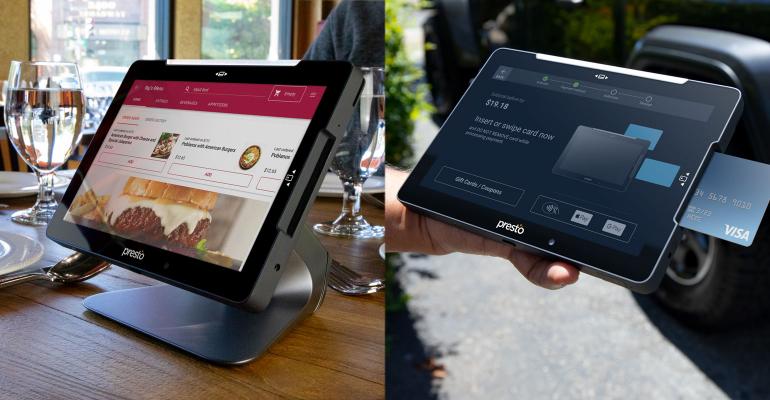Sponsored by Presto
Over the last decade, the restaurant industry has seen incredible progress in the variety and performance of technologies—including guest DIY technologies and staff-enabling tablets—that empower QSRs and fast casual chains. The problem, though, is that each of these tools has traditionally had a standalone function. Tabletop tablets remain at tables; server handheld devices stay firmly in servers’ hands.
Today’s restaurants are battling multiple headwinds, from pandemic-related restrictions to a pervasive labor shortage, and continued industry-wide challenges and changes are near certainties. A single function for a single device is no longer good enough.
Now, restaurants need technology that’s as versatile as they are, and which supports—rather than hinders—leaner-than-ever staffs. The restaurant industry and its operators should expect and demand a single device that meets multiple needs, and which keeps restaurants flexible and high-performing.
The evolving landscape of restaurant technology
Certain technologies are now almost as prevalent as French fries at QSR establishments. A recent Deloitte study found that most customers prefer to place their orders digitally—whether they’re at the restaurant (58%) or not (70%).
Savvy restaurant operators have leaned into these trends by deploying a suite of tech-enabled hardware across their establishments. These tools include:
Guest DIY Technologies
“Classic” technology solutions for restaurants include guest DIY technologies like tabletop tablets, kiosks, and QR codes. These allow guests to place orders, play games, pay bills, and share feedback with ease. In recent years, technological advances have made pay-at-table solutions more secure, and software that allows guests to sign into their accounts, view past orders, and store their dietary preferences creates the kind of personalized experience today’s guests increasingly expect.
Despite progress, however, each of these tools has its shortcomings, and they remain differentiated point solutions that don’t work seamlessly together. QR codes don’t integrate with tabletop devices, tabletop tablets have short battery lives, and each tool has a limited feature set.
Staff Tablets
The pandemic caused drive-thru orders to skyrocket, and line-buster devices became business-critical for QSRs. According to a SeeLevel HX study, the average time a consumer spent in a drive-thru at 10 top QSRs increased by 29.8 seconds from 2019 to 2020. Those delays could lead to an average of approximately $32,000 in losses per store.
Line-buster devices allow servers to “bust” long lines at drive-thrus by enabling them to take customers’ orders and payments on handheld devices. This helps lines move more quickly, creates a better experience for drive-thru guests, and increases profitability for restaurants.
Likewise, handheld devices can free servers from the anchor of the POS terminal by allowing them to view guest profiles, enter orders, take payments, and receive feedback on the go.
While staff devices are critical in optimizing efficiency and delivering a better customer experience, the current generation of products has several drawbacks. Many of today’s server tablets are heavy, have a short battery life, and are not weather-proof. These limitations are frustrating for servers—and can be costly for operators.
Moving Toward an All-in-One System
Restaurants have realized myriad benefits from implementing technology across their locations. But what if, instead of purchasing multiple distinct tools, they could deploy an all-in-one device to meet their needs?
Today’s operators should demand a multipurpose device with next-generation features and functionality, which allow it to best serve its ultimate goals of augmenting restaurant staff, improving the customer experience, and expediting transactions. That means this device should be:
- Easy for servers to carry. Whether they’re busting lines in a drive-thru or racing from table to table within the restaurant, servers need devices that won’t weigh them down. A next-gen device should be lightweight, portable, and fast-loading, with a long-lasting battery capacity.
- Designed for use in multiple environments. The ideal solution is a versatile tablet that can be interchangeably deployed for various applications and should work equally well in a drive-thru line and on a table. That means the device should have flexible WiFi and LTE connectivity, come with a glare-resistant screen and all-weather ruggedization, and be enabled with voice technology that allows guests and servers to place orders easily, even in a noisy location.
- Payment-enabled. A server quickly loses the benefit of a handheld ordering device if s/he has to make constant trips to the POS terminal. Next-gen devices should all be payment-enabled in order to expedite transactions and improve both the guest and the customer experience. As a bonus, a device with both front and rear cameras enables easier coupon scanning and a superior guest experience.
Versatility Is the Name of the Game
Uncertainty has defined the last year—and it’s become the new normal in the restaurant industry. Today’s operators will need to continue to embrace technology as a way to drive efficiency, reduce reliance on staff, and improve the customer experience. Now, though, they should not settle for point solutions for multiple use cases. Technology has evolved to the point where it’s reasonable—and prudent—for restaurants to seek a multipurpose, all-in-one solution that will help them combat the multiple challenges they face as efficiently and effectively as possible.
So, by all means, check out that new product for your front of house—just make sure it’s built on best-in-class tech with an all-in-one architecture. If you make the wrong decision now, you might be stuck with an obsolete ecosystem for a long time.



